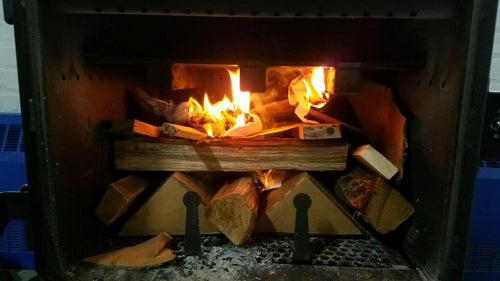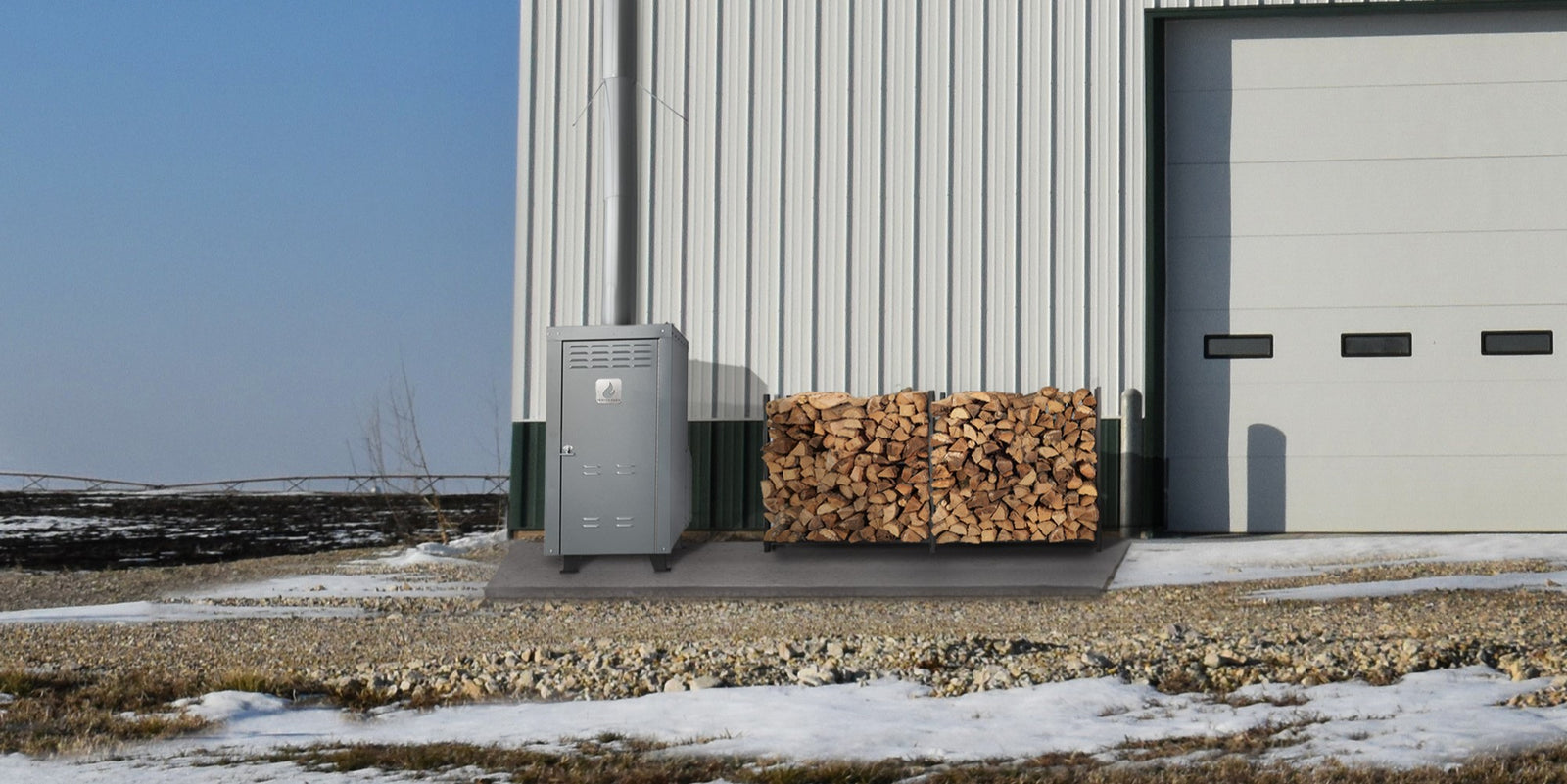How to Increase Draft in Your Chimney
July 19, 2023

Draft is the driving force that pulls smoke up the chimney allowing a fire to burn effectively in a fireplace or a wood stove. A fireplace or a wood stove with poor draft will make it difficult to get a fire going and will cause smoke to roll out of the front of the fireplace or wood stove. Smoke rolling out of the fireplace or wood stove is very unpleasant and causes soot stains on the walls and ceiling. This will also cause the home to smell like smoke and soot, making your living conditions not ideal. Improving the draft of your wood stove or fireplace will ensure all the smoke properly vents out of the home.
1. Start with a Hot, Fast Fire
Starting a cold wood stove with a hot, fast fire will get the draft going the quickest. Being lazy starting a fire can cause a lot of smoke to linger into your living space. It is best to get the fire going hot and quickly. Generating a lot of heat into the flue will cause the draft to start more quickly and effectively pull the smoke up the chimney. The best practice is to start a fire with the top-down technique.How: Build a Fire Top Down
The top-down fire starting technique will create more heat directed to the flue and increase the draft. You will start with large, normal size pieces of wood for the base of the fire. Then, put a layer of paper balls or knots on the bottom layer. The next layer is going to be 5 or 6 more finely split pieces of wood about 2 to 3 inches in diameter. Next, another layer of paper. Place a very fine layer of kindling on the top and cover it with knots of paper. The knots will cause the paper to burn more slowly. As the top layer ignites it will cause each of the next two layers to catch, creating the top-down fire. It is important to cross the layers of wood creating turbulence for the fire. Turbulence is crucial for wood to burn effectively. Tightly stacked wood is not going to have enough movement for air to become turbulent enough to drive the fire.
2. Burn Extremely Low Moisture Wood

The key to having a hot, fast fire is to burn wood with a 20% or lower moisture content. Wood with a high moisture content will burn slowly and lose most of the efficiency of the wood. The fire is basically boiling off the excess moisture before the wood can fully combust. Moist wood will make the top-down fire starting method extremely difficult. A good draft starts with a well-lit fire.
How: Use Logs that Have Lower Than 20% Moisture Content
The best way to get your wood to low moisture content is to properly stack and store your wood. Just like building a fire, the wood should be stacked loosely so air can move all around the wood. The wood should be stacked outside and covered so no driving rain can hit the wood. This will allow the wind to move through the wood and dry it out. You should not cover the wood tightly with a tarp. Rain may not be getting on the wood in this scenario, but the tarp is trapping the moisture inside the pile, causing condensation to form which will take longer for the wood to dry out. Hardwoods such as Oak, Maple, and Ash are the best types of wood to burn in a fireplace or a wood stove. Hardwoods, if stored properly, will take about 1 to 2 years depending on the size of the split logs. Purchasing a Moisture Meter is the best way to gauge the moisture content of the wood.
3. Improve Airflow Around the Fire
Burning a hot fire is pivotal to having a good drafting chimney. One way to improve the performance of the firebox is to add a fireplace grate.
How: Use a Fireplace Grate
A fireplace grate is going to allow more air movement through the wood, creating more turbulence which a fire loves. Every wood burning fireplace should have a fireplace grate. If you have a wood burning stove, you will have to check with the manufacturer of the stove to determine if a fireplace grate is approved for that particular stove. Newer EPA-rated wood stoves are designed to fully load the stove with wood allowing for longer burn times. A fireplace grate could actually hinder the efficiency of the EPA-rated stove by making the wood burn more quickly. While that will help improve the draft, it is going to hinder the efficiency of the stove. Burning with a fireplace grate in a wood stove could also void the warranty of the stove. You would want to check with the manufacturer before you make that decision.
4. Warm the Chimney Flue
One of the best ways to get the draft going in a cold chimney is to prime and heat up the flue. In extremely cold climates this might be required to even establish a draft. A very cold chimney can create a cold bubble that basically blocks the flue and the draft. If you try to start a fire with an extremely cold chimney, you could fill the home with smoke because the chimney is so cold, the heat from the fire cannot overtake the cold flue resulting in a smoky fireplace or wood stove.
How: Prime the Flue Before You Start a Fire or Increase the Height of the Grate or Basket
There are many ways to preheat the flue. You can use common household products such as a hair dryer, large three-wick candle, a heat gun, or a handheld propane torch to preheat the flue. Place the heating element up the flue for a minute or two and that can create enough heat to establish a draft. There is also a product called the Draw Collar which is a heating element that is built into a section of stove pipe. This will create up to 400 degrees inside the stove pipe and drive the smoke up the chimney. The Draw Collar is the best product to ensure you do not have a smokey wood stove when you attempt to light it on a cold start.
5. Provide Enough Air to Replace the Air That is Lost
A key component for burning wood is oxygen and fresh air. The more fresh air you have the hotter the fire is going to be. As the fire burns, it is pulling all the fresh air from the home as it continues to burn. There can be a point where the fire has depleted the room of fresh air and the fire will start to smoke and die out.
How: Open a Window or Vent in the Room the Chimney is In
A newer home that is constructed to be energy efficient and very airtight can cause a woodstove or a fireplace to pull the fresh air out more quickly, thus hindering the draft. If this happens you can crack a window or a door for a few minutes to provide fresh air to the stove or fireplace. You can also install a fresh air intake directly to a wood stove to provide a constant supply of air to the stove if the stove is equipped with this capability. You can install a fresh air intake hood on the side of your home and run a pipe through the wall to the back of your stove. It is very important to install a fresh air intake in a newer constructed home that is designed to be extremely airtight.
What If These Steps Do Not Improve Your Fireplace Draft?
You could be doing everything correctly with how you store your wood, build a fire and run your stove and you are still experiencing poor draft. This could be a result of the configuration of your chimney or stove pipes. A free standing wood stove should never have more than two 90 degree elbows in the stove pipe configuration. More than two 90 degree elbows will inhibit the draft because there is too much resistance for the exhaust. You could fix this problem by reconfiguring your stove pipes and use 45 degree elbows instead of 90 degree elbows.
Another reason could be a long run of horizontal stove pipe. Smoke and heat strive to rise, but having a long horizontal section of stove pipe will make the smoke rise slower and hurt the draft. A horizontal stove pipe should also not be truly horizontal. The stove pipe should have a minimum of a 1/4" of rise per foot of horizontal stove pipe heading to the chimney. The length of the horizontal stove pipe should not be greater than 50% of the height of the chimney. A simple reconfiguration of the stove pipes can drastically change and help the draft of the stove. If you choose not to reconfigure the stove pipes, you could use an inline draft inducing fan. The AD-1 Auto Draft Fan mounts to the side of a single wall stove pipe and it will force the smoke up and out, creating a better draft.
A reason a fireplace could have poor daft can be caused by an insufficient flue size. This happens more times than you would like to see. The biggest construction fail that can happen is when the fireplace was built too large for the flue size. If the flue size is not in scale with the opening of the fireplace, it will cause poor draft. There is simply not enough area in the flue to account for the volume of smoke created by a large fireplace. The general rule is that the area of the flue should be no less 1/12th the face area of the fireplace for round flues and no less than 1/10th of the fireplace for square flues and rectangle flues with an aspect ratio less than 2 to 1. Rectangle flues with an aspect ratio greater than 2 to 1 will require the flues size to be no less than 1/8th of the face opening of the fireplace. If you find yourself owning a fireplace where the flue is too small for the fireplace, you can improve the draft by reducing the size of the opening of the fireplace. This can be achieved by installing a Smokeguard on the top edge of the fireplace. This will effectively lower the height of the fireplace opening, reducing the area of the fireplace. In the event the flue size is extremely too small for the fireplace, you can install an Enervex Top Exhaust Fan to exhaust the smoke and create a positive draft.
One of the most common causes of poor draft for a fireplace and a wood stove is insufficient chimney height. Even though your chimney may be up to code and the correct height above the roof, your chimney can still not be tall enough for proper draft. Generally, the more distance you have between the hot fire and the outside cold air will create a stronger draft. Wood stove manufacturers generally state that the minimum chimney height should be no less than 15'. Based on their tests, 15' is the height where you will start to have an optimal draft. You can install a Specialty Flue Extension to increase the height of your chimney to help improve the draft.
If your fireplace or wood stove has worked perfectly for a while and you start noticing that it is not drafting like it always has. The reason could be a dirty or blocked chimney flue. When the flue begins to accumulate creosote the flue area begins to shrink. If the flue is blocked and too much creosote has built up on the wall of the chimney, it will not have enough area to have a proper draft. The easiest way to fix the draft issue in this situation is to simply clean the chimney flue. The SootEater Rotary Cleaning System is a great tool to clean the chimney. The whip cleaning head will get into every crevice of the chimney liner removing the creosote from the walls of the chimney creating the proper area in the flue to properly exhaust the smoke. Not to mention cleaning the chimney flue is extremely important to prevent chimney fires.
DIY Center
(AKA ‘The Rockford Files’)
From video tutorials to product walkthroughs, we have a variety of DIY resources just for you! Click the button below to view our entire library.








